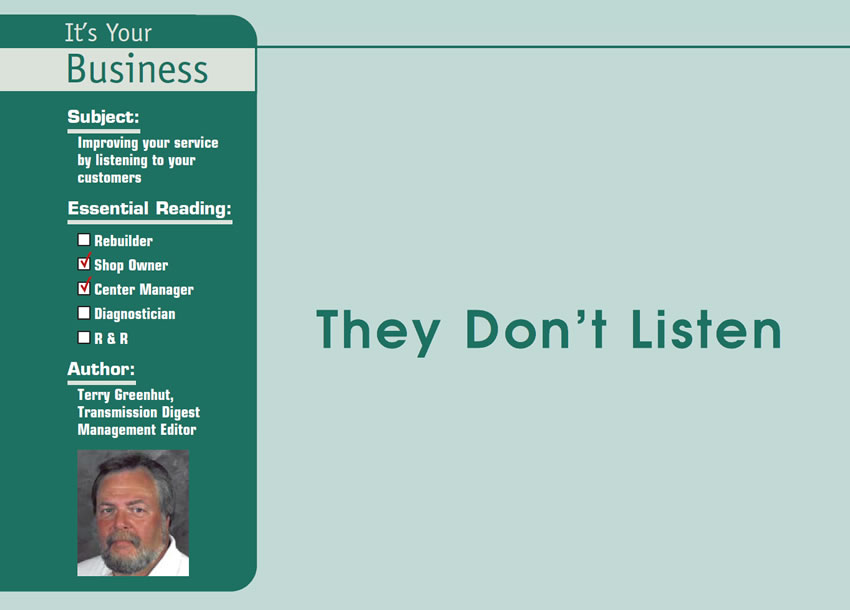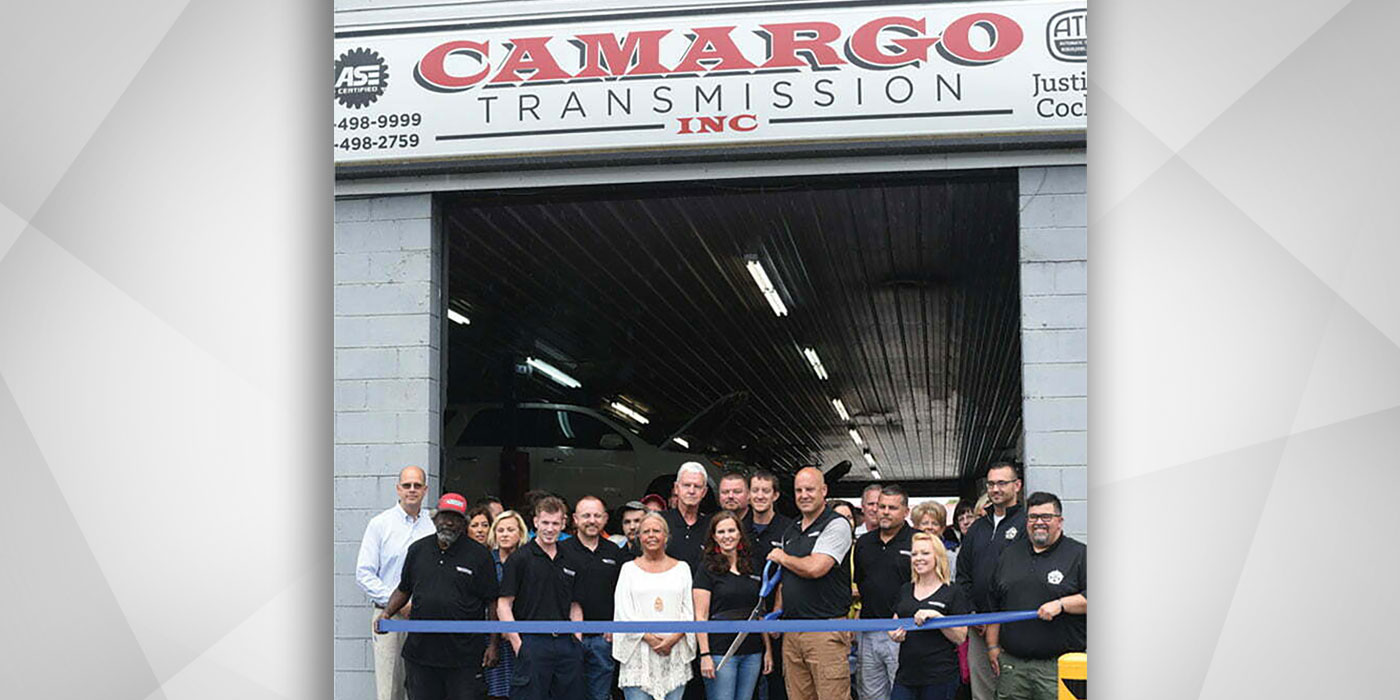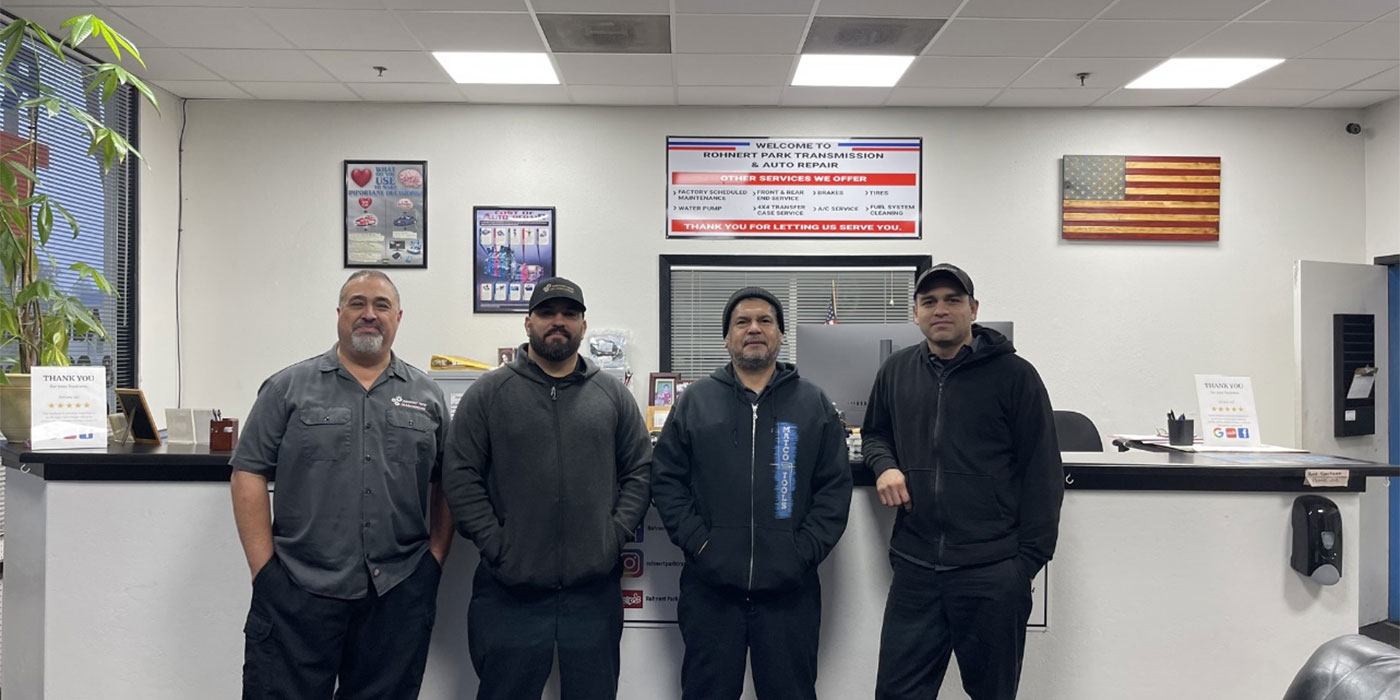
It’s Your Business
Subject: Improving your service by listening to your customers
Essential Reading: Shop Owner, Center Manager
Author: Terry Greenhut, Transmission Digest Management Editor
What do lots of owners whose small businesses get into trouble have in common? They don’t listen. Maybe they don’t even ask, but the fact remains that they have major difficulties because they assume they know what their customers want and need. Finding out could save the lives of their businesses and allow them to prosper. Their lack of listening skills also gets them into trouble when they’re trying to handle customer-relations issues. We’ll look at both problems.
Stew Leonard, a grocer from Connecticut, had a vision. He wanted to turn his little grocery store into a chain of relatively high-end establishments in which people would be willing to pay more for better products and a much higher level of service than the one to which they had become accustomed. He went on to expand his little store and put in an array of specialty meats and produce, the quality of which could not be matched anywhere in the area. Word spread and people began to come in, but this wasn’t good enough for old Stew. He wanted to know how he could sell more and different products while making the shopping experience an event to which people might actually look forward.
Stew decided that the best way to find out what his customers wanted was to ask them and then make sure he took prompt action to incorporate their reasonable and feasible desires into his business model. To gather the necessary information he would invite groups of customers to spend an hour answering questions that would indicate what they thought the store did well and what could be done to make it better. There were questions about store layout and cleanliness, the scope and quality of products offered, how shopping could be made more convenient, and what goods and services should be added. There were even taste tests of new or exotic products that people really came to love. As a result, he didn’t have much trouble recruiting participants.
All the research paid off. Stew Leonard’s developed some of the best departments in the business. Its meats, produce, deli and prepared hot- and cold-foods counters are some of the best you’ll see anywhere. There are so many choices you might never have to cook again if you don’t want to.
The store layout is ingenious as well. You walk through a series of “S” curves that take you from initial entry all the way to the cash registers, making you walk through and experience the sights, sounds and aromas of every department along the way. There are free samples for you to taste throughout the store, and if you get really hungry you can fix yourself a plate of food and sit down at one of the many tables and eat, paying for it on your way out. For this reason, many customers spend more than they had intended when they first came in but leave feeling good about it and wanting to return.
One thing that became abundantly clear in the focus-group meetings was that customers want to be well taken care of whether they are spending big money or just a little. They want to be made to feel special. Good-tasting food served with a bad attitude just wasn’t going to be tolerated. So Stew set out to hire the best people he could find. He pays higher and expects a whole lot more from his employees. Unlike many food chains, Stew Leonard’s puts candidates through several rigorous interviews and bases raises on the number of “Attaboys” received from happy customers.
How sure are you that your customers are happy with the types of services you provide and are satisfied enough to keep coming back and recommending their friends and family? Do you ever ask, or is it one of those deals where you figure it’s better to let sleeping dogs lie? Are you afraid to have customers tell you how they really feel because as long as you don’t know it’s broken, you don’t have to do anything to fix it?
Customer-service issues are nothing to hide from. Any problems you uncover should be used as a training mechanism to ensure that they don’t recur in the future. Even though we consider any customer complaint the equivalent of a slap in the face – so we want as few of them as possible – we need to know so we can fix the problems. The fact is, we don’t get enough complaints. Many customers don’t voice their concerns. They just leave a little dissatisfied. It may not even be enough to keep them from coming back, but it is enough that they will try someone else’s service if it is convenient for them to do so. Our goal is to have them never want to try anyone else’s service, to not even think along those lines.
Some of the issues that make customers want to leave us and must be addressed are:
Rudeness – This one is intolerable and just plain stupid. If you can’t role-play well enough to interact smartly with customers you should either not do it at all, develop a new attitude toward them or get psychological help. If you have employees who are rude to your customers, warn them once. The second time, fire them. They are killing your business.
Broken promises – Under-promise and over-deliver. Give yourself extra time in estimating when you’ll have a car finished. If you get it done earlier, that’s great. If you promise to fix that little extra thing the customer mentioned on his way out the door, make sure you do it. It will be the first thing he’ll look at upon his arrival to pick up the car.
Arguments – I’ll say it one more time: “You can’t win an argument with a customer.” When you argue, both of you just dig in your heels and try to maintain your position, right or wrong. Think down the road. Even if you win the argument, is it worth losing the customer? That’s what likely will happen. It would always be best to find an alternative solution that you both can accept.
Indifference – The old “I don’t care” attitude. If you really don’t care about your customer’s well-being, maybe it’s time to find another line of work, one in which you can hide in a back room and never have to deal with those pesky little customers again. Indifference by anyone with whom a customer comes in contact is one of the biggest contributors to lost sales and customers. Many more people today believe, “If you don’t want to treat me right, I’ll find someone else who will appreciate my money.”
Impatience – You know your business. Your customer may not. Even though you want to get to the meat of the problem, the customer may take her time getting around to it as she tells you her story. Don’t rush her. Listen as if this were the first time you ever heard such a problem. When you try to rush people you make them quite uncomfortable.
Misinformation – A nice term for lying. “Oh, what a tangled web we weave when first we practice to deceive.” How true, and for most of us who are trying to process a hundred different thoughts at the same time, we can’t remember which lie we told to whom, about what and when. So it’s probably better just to tell the truth.
Gloom and doom – There are some people in this world who walk around with a cloud consistently over their heads, and it’s usually raining on them. Customers don’t want to deal with people like that. They have their own troubles. They don’t want to hear about yours. In fact, they would rather not think that you have any. They would like to think that they are dealing with someone whose business is in good shape, if for no other reason than that you’ll be there to honor your warranty. They want someone who is upbeat and enthusiastic about the business and about life in general, someone who is pleasant and maybe even fun to deal with.
Do’s and don’ts for telephone customer relations:
- Do smile when you answer the phone. Make it sound as if you are happy to take the call. If it helps, picture money on the other end of that phone line.
- Don’t let the phone ring too many times. Try to answer it by the third ring. It shows that you care about the caller’s time.
- Do give your name when you answer. It lets the caller know you are not hiding and begins to establish some common ground.
- Don’t hem and haw and hesitate to offer your help in any situation. Think about taking care of problems first and working out the money as a secondary goal.
- Do take good messages for others.
- Don’t make customers call back to find out the status of their vehicles. Call them when you have news or to tell them when you might.
A little “Golden Rule common sense” goes a long way in dealing with customer-relations issues. Keep your eye on the prize, which in this instance is keeping the customer.

Visit www.TerryGreenhut.com.













